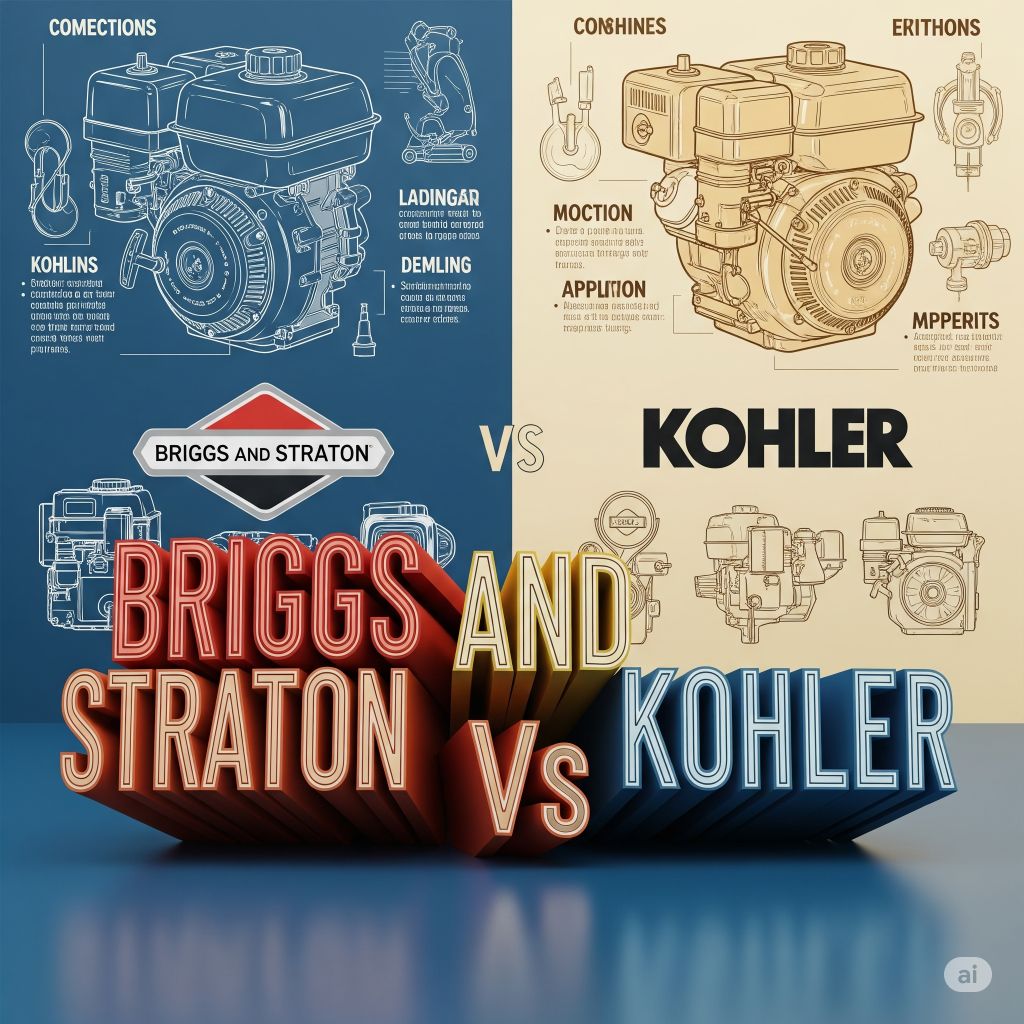
Choosing between a Briggs & Stratton and a Kohler engine for your lawn mower, generator, pressure washer, or other outdoor power equipment can be a critical decision. Both companies have long, storied histories and are synonymous with reliable small engines. While they both produce powerful and durable engines, they have distinct philosophies, technological approaches, and market niches. This comprehensive comparison will delve into the details to help you understand which engine might be the best fit for your needs.
Brand Overview
Briggs & Stratton
- History: Founded in 1908 in Milwaukee, Wisconsin, Briggs & Stratton is the world’s largest producer of gasoline engines for outdoor power equipment. They have a long-standing reputation for mass production, accessibility, and widespread use in consumer-grade equipment.
- Focus: Primarily on residential and light commercial applications, emphasizing ease of use, widespread parts availability, and affordability.
- Market Presence: Dominant in the consumer market, found on a vast majority of walk-behind mowers, residential riding mowers, and entry-level generators.
Kohler Engines
- History: Founded in 1873 by John Michael Kohler as a plumbing and casting company, Kohler entered the engine market in 1920. They quickly established a reputation for producing durable, industrial-grade engines, particularly for demanding commercial applications.
- Focus: Known for robust construction, advanced features (like hydraulic valve lifters), and engines designed for heavy-duty, commercial, and industrial use, alongside a strong presence in the consumer market.
- Market Presence: Strong in both consumer and professional/commercial equipment, including higher-end riding mowers, zero-turn mowers, generators, and construction equipment.
Technology and Design
Briggs & Stratton
- Engine Design: Known for simple, robust designs that are easy to manufacture and maintain. They offer a wide range of engine types, from single-cylinder flatheads to V-twin overhead valve (OHV) engines.
- Innovation: Has introduced various technologies like ReadyStart® (no priming, no choking) for easier starting, Just Check & Add™ (no oil changes required, just topping off), and innovative air filtration systems.
- Build Quality: Generally good for consumer use, with some commercial-grade series (e.g., Commercial Turf Series) designed for heavier duty. Many parts are interchangeable across different models, simplifying repairs.
Kohler Engines
- Engine Design: Often features more advanced designs, including full-pressure lubrication systems with oil filters, hydraulic valve lifters (reducing maintenance), and industrial-grade components. Their Command Pro and Courage Pro series are well-regarded.
- Innovation: Emphasizes precision engineering and features that contribute to longer engine life and performance under strenuous conditions. Many Kohler engines are designed for vertical or horizontal shafts to fit specific equipment.
- Build Quality: Renowned for their rugged construction and commercial durability. They are often perceived as being built to tighter tolerances and with more premium materials for professional use.
Common Applications
Briggs & Stratton
- Residential Equipment: Walk-behind mowers, entry to mid-range riding mowers, push mowers, consumer-grade pressure washers, small generators.
- Light Commercial: Some higher-tier V-twin engines are used in light commercial zero-turn mowers and chippers.
Kohler Engines
- Commercial Equipment: High-end residential riding mowers, zero-turn mowers, commercial pressure washers, professional generators, welders, compact construction equipment.
- Residential Equipment: Also found in mid to high-end residential lawn and garden tractors, often where premium features or increased durability are desired.
Reliability and Durability
Briggs & Stratton
- Overall Reliability: Generally reliable for their intended residential use. With proper maintenance (oil changes, filter replacements), they can last for many years.
- Durability Concerns: Some budget-friendly models might use more plastic components or simpler designs, which can lead to earlier wear if not maintained or if subjected to heavy commercial use beyond their design.
Kohler Engines
- Overall Reliability: Highly reliable, especially kohler commercial-grade engines. Designed to withstand more rigorous and prolonged use.
- Durability Strengths: Features like cast-iron cylinder liners, full-pressure lubrication with spin-on oil filters, and heavy-duty bearings contribute to extended lifespan and performance in demanding environments.
Maintenance and Repair
Briggs & Stratton
- Ease of Maintenance: Very straightforward for basic maintenance tasks (spark plug changes, oil changes, air filter replacements). Parts are widely available and relatively inexpensive.
- Repairability: Simple design makes them generally easy to repair for both DIYers and professional mechanics.
Kohler Engines
- Ease of Maintenance: Also designed for straightforward maintenance. Full-pressure lubrication with oil filters can extend oil change intervals on some models. Hydraulic valve lifters (on some models) eliminate the need for periodic valve adjustments.
- Repairability: While generally easy to work on, some of their advanced features or commercial-grade components might require more specialized tools or knowledge for complex repairs. Parts may be slightly more expensive.
Cost
Briggs & Stratton
- Initial Cost: Generally more affordable, making equipment powered by Briggs & Stratton engines more accessible to the average consumer.
- Parts Cost: Replacement parts are typically less expensive due to high production volumes.
Kohler Engines
- Initial Cost: Often command a slightly higher price point due to their advanced features, robust construction, and commercial-grade components. This contributes to a higher overall cost for the equipment they power.
- Parts Cost: Replacement parts can be a bit more expensive, reflecting the quality and specialized nature of some components.
Summary Table
| Feature | Briggs & Stratton | Kohler Engines |
|---|---|---|
| Primary Market | Residential, light commercial | Commercial, high-end residential, industrial |
| Design Philosophy | Mass-produced, accessible, user-friendly | Robust, precision-engineered, heavy-duty |
| Technology | ReadyStart, Just Check & Add (consumer focus) | Full-pressure lubrication, hydraulic valve lifters |
| Reliability | Very good for residential use (with maintenance) | Excellent, built for demanding conditions |
| Maintenance | Simple, easy DIY, widely available parts | Straightforward, some advanced features (less adjustment) |
| Cost | Generally more affordable | Often higher initial and parts cost |
| Common Uses | Walk mowers, push mowers, entry-level riders | Zero-turns, commercial mowers, generators |
Conclusion
Both Briggs & Stratton and Kohler are reputable engine manufacturers, but they cater to slightly different segments of the market.
- Choose Briggs & Stratton if you:
- Are a homeowner with a typical residential yard.
- Prioritize affordability and ease of basic DIY maintenance.
- Need a reliable engine for light to moderate use.
- Choose Kohler if you:
- Are a professional landscaper or have a large, demanding property.
- Require an engine designed for extended, heavy-duty use.
- Are willing to pay a premium for robust construction and advanced features that contribute to longevity and consistent performance under stress.
Here’s a comparison table focusing on specific models from Briggs & Stratton and Kohler, categorizing them by typical application (residential vs. commercial-grade) and highlighting their key features. This will give a clearer picture of how specific engines from each brand stack up.
Briggs & Stratton vs. Kohler: Specific Engine Model Comparison
This table provides a direct comparison of popular and representative engine models from both Briggs & Stratton and Kohler, highlighting their intended use, technology, and common applications.
Okay, here are the two tables, split as requested, to clearly differentiate between the residential/mid-grade and commercial-grade engine offerings from Briggs & Stratton and Kohler.
Part 1: Residential/Mid-Grade Engine Comparison
This table focuses on the engine models from Briggs & Stratton and Kohler that are typically found in residential and light-duty commercial equipment. These engines balance performance with affordability and ease of use for the average homeowner.
| Feature/Model | Briggs & Stratton (Residential/Mid-Grade) | Kohler (Residential/Mid-Grade) |
|---|---|---|
| Engine Series | EXi / ReadyStart / Intek | 7000 Series / Courage |
| Typical HP Range | 14 – 23 HP (single/V-twin) | 18 – 26 HP (V-twin) |
| Engine Type | OHV (Overhead Valve) | OHV (Overhead Valve) |
| Cylinder Type | Aluminum alloy with cast iron sleeve | Aluminum alloy with cast iron liner |
| Lubrication System | Pressure lubrication with spin-on oil filter | Full-pressure lubrication with spin-on filter |
| Oil Change Interval | Standard (e.g., 50-100 hrs for EXi) | Standard (e.g., 50-100 hrs) |
| Starting Feature | ReadyStart (no choke/prime needed) | Smart-Choke™ (on some Courage models) |
| Air Filtration | Dual-element or standard paper | Standard paper or Cyclonic |
| Valve Lifters | Mechanical (require adjustment) | Mechanical (require adjustment) |
| Common Equipment | Residential riding mowers, push mowers, generators | Mid-grade residential riders, light ZTRs, walk-behinds |
| Perceived Durability | Good for residential use | Good for residential/light commercial use |
Part 2: Commercial-Grade Engine Comparison
This table highlights the top-tier, heavy-duty engine models from Briggs & Stratton and Kohler, designed for demanding professional, commercial, and industrial applications where durability, sustained performance, and advanced features are paramount.
| Feature/Model | Briggs & Stratton (Commercial-Grade) | Kohler (Commercial-Grade) |
|---|---|---|
| Engine Series | Commercial Turf Series (CTS) / Vanguard | Command PRO / KT Series |
| Typical HP Range | 20 – 37 HP (V-twin) | 19 – 38 HP (V-twin) |
| Engine Type | OHV (Overhead Valve) | OHV (Overhead Valve) |
| Cylinder Type | Cast iron cylinder liners | Cast iron cylinder liners |
| Lubrication System | Full-pressure lubrication with spin-on filter | Full-pressure lubrication with spin-on filter |
| Oil Change Interval | Extended (e.g., 100-200 hrs) | Extended (e.g., 100-200 hrs) |
| Starting Feature | Electric start | Electric start |
| Air Filtration | Advanced Cyclonic or 5-step integrated | Heavy-duty cyclonic, multi-stage |
| Valve Lifters | Mechanical (require adjustment) | Hydraulic (no adjustment needed) |
| Common Equipment | Commercial ZTRs, generators, pressure washers | Commercial ZTRs, industrial equipment, large riders |
| Perceived Durability | Excellent, built for demanding conditions | Excellent, built for industrial/heavy commercial use |
Key Takeaways from Model Comparison:
- Residential Offerings:
- Both brands offer solid V-twin engines for residential riding mowers.
- Briggs & Stratton’s EXi/ReadyStart focuses on extreme ease of starting and simplified maintenance (like “Just Check & Add”).
- Kohler’s 7000 Series often emphasizes smoother operation and features like a reliable lubrication system.
- Commercial-Grade Engines (Where the Real Differences Emerge):
- Briggs & Stratton Vanguard: This is their top-tier commercial line. Known for reliability, easy maintenance, and robust performance. They use cast-iron sleeves and heavy-duty components.
- Kohler Command PRO / KT Series: These are Kohler’s workhorses. They are often perceived as having an edge in features like hydraulic valve lifters (which eliminate valve adjustments for life), and very robust, purpose-built components for industrial applications. Their filtration systems are often highly advanced.
- Build Materials & Longevity:
- Both brands use cast-iron cylinder liners in their better engines, which significantly prolongs engine life compared to plain aluminum cylinders.
- Full-pressure lubrication with spin-on oil filters is standard on virtually all V-twin engines from both brands, which is crucial for engine longevity.
- Innovation Focus:
- Briggs & Stratton tends to innovate more on the “ease of use” and “maintenance simplification” side for residential users (e.g., ReadyStart, Just Check & Add).
- Kohler’s innovation often focuses on “industrial durability” and “professional performance” features (e.g., hydraulic lifters, advanced filtration).
This table highlights that while both brands compete, their top-tier offerings showcase their respective strengths and design philosophies, making them suitable for different user needs and expectations.

I’m David man behind Lawn Mowerly; I’ve been dealing with lawnmowers and Tractors with my father since I was a kid. I know every make and model and what each one is capable of and love helping people find the perfect lawn mower for their needs.
